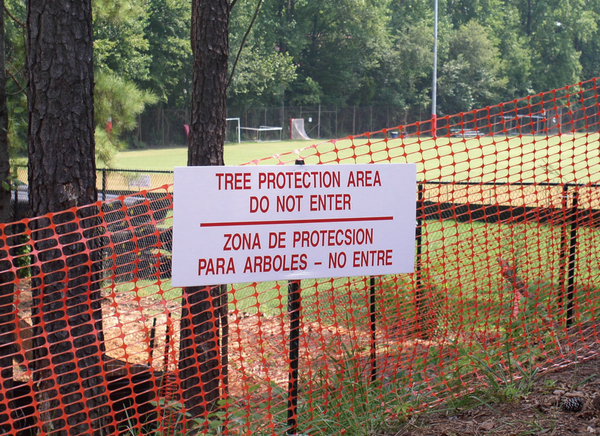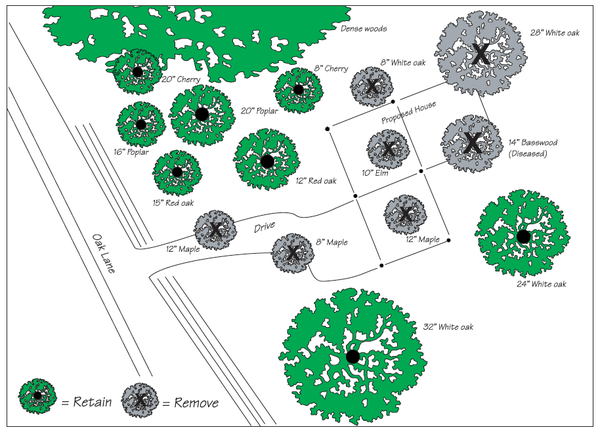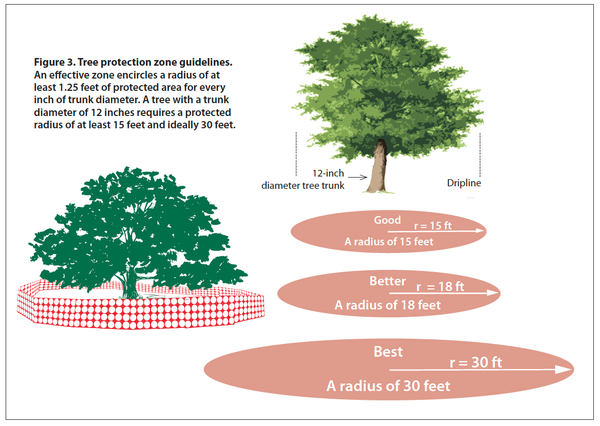Protecting trees during construction can yield big rewards. Planning and prevention are the keys to success. Achieve the best results by taking action to prevent tree damage during site development and construction.
This publication describes some tree protection strategies that builders and developers can use before, during, and after construction to conserve healthy trees. Community actions to encourage tree protection and reduce the risk of injuring or losing valuable trees are highlighted.
Conserving the right trees can reap rewards for developers, homeowners, and communities. Healthy trees enhance property values and community development by providing shade, wildlife habitat, and beauty. Sickly, stressed trees reduce property values, discourage potential buyers and detract from a community. Post-construction maintenance and removal of trees is difficult and expensive. Replacing trees after construction can also be costly and time consuming.
Before Construction
-
Take stock of trees on the site. Hire a professional arborist or urban forester to inventory existing trees. An inventory records the variety, location, size, and health of each tree. A proper tree inventory creates the foundation for a successful tree protection plan. A professional can identify valuable trees and those that need attention or removal.
Identify any stressed trees that need removal. Stressed, unhealthy trees have wilting leaves, dying limbs, thinning crowns or other signs of declining health. Always remove insect-, disease-, or storm-damaged trees prior to construction. This is fast, efficient, and saves resources.
- Draw a base map. Include all the important site features such as existing vegetation, property lines, utility connections, slopes, and required setback distances before drawing in the proposed building(s):
- Map grading and drainage.
- Identify priority trees for protection. Mark their locations on the base map and sketch in approximate tree protection zones where temporary fences should be located around priority trees.
- Locate the building footprints: the areas where structures and their amenities will affect the landscape. Draw in the driveways, parking areas, and decks.
- Mark trees that need to be removed or pruned to make room for future structures and construction equipment.
- Prepare a tree protection plan. A tree protection plan designates the valuable trees that must be protected during the construction process. Assemble a team to write a tree protection plan before ground is broken. The team should include the site managers as well as professionals who can provide tree protection advice. Do not leave anyone out who should be involved. By working together, the team can identify potential conflicts between construction needs and tree protection, and identify compromise solutions.
A Successful Tree Protection Team
- Arborist
- Architect
- Builder or developer
- Construction supervisor
- Engineer
- Homeowner
- Landscape architect
- Planner
Planning takes time, but it pays off during and after construction. Using the base map, the team can plan for tree protection, foresee problems, and solve them. Early planning helps to keep construction on schedule, reduce costs, and avoid conflicts:
- Locate construction activities after considering the priority trees and the development requirements.
- Look for potential conflicts, and explore alternate solutions.
- Consider grading and stormwater drainage. Remember that cutting or filling around roots will weaken and eventually kill valuable trees. Weigh alternatives such as retaining walls to protect priority trees.
- Designate tree protection zones (TPZs). The protection plan should specify the location of temporary tree protection fences to protect trees and their root zones during construction. TPZ fences identify “exclusion zones” where construction and equipment use is prohibited.
- Identify techniques that will protect valuable trees. (See some of the TIPS mentioned later in this publication.) A tree professional can develop a schedule of tree maintenance activities, including watering, mulching, and fertilization. Stay committed to this plan throughout the project.
-
Erect TPZ fences. Restrict access to TPZs, with tall, bright, protective fencing. Most fencing is inexpensive and durable enough to last throughout most construction projects. Temporary tree protection fencing should be erected before clearing, deliveries and other construction activities begin on the site. Effective TPZs maintain a radius of at least 1.25 feet of protected area for each inch of trunk diameter (Table 1).
Table 1. Mature tree protection zone guidelines. Trunk Diameter Mature Tree Protection Zone Radius Good Protection Better Protection Best Protection 8 inches 10 feet 12 feet 20 feet 12 inches 15 feet 18 feet 30 feet 16 inches 20 feet 24 feet 40 feet 20 inches 25 feet 30 feet 50 feet
During Construction
- Prohibit or restrict access to TPZs. All on-site workers should be aware of the TPZs and the restrictions on activities within the zones. Use these TPZ guidelines for the best effect:
- Post “keep out” signs on all sides of fencing. Do not store construction equipment or materials in TPZs.
- Prohibit construction activities near the most valuable trees, and restrict activities around others.
- Assess crew and contractor penalties, if necessary, to keep the TPZs intact.
- Monitor trees. Vigilance is required to protect trees on construction sites. Use a tree professional or train your staff to monitor tree health during and after construction on a regular, frequent basis. Watch for signs of tree stress, such as dieback, leaf loss, or general decline in tree health or appearance.
- Monitor TPZ fences. Assign a crewmember the weekly responsibility of checking the integrity of TPZ fences. Repair and replace TPZ fencing as needed.
- Optimize tree health. Assign a trained crewmember or hire a professional to complete regular tree maintenance tasks, including watering, fertilization, and mulching to protect tree roots. Consult a tree professional for advice on these practices if needed. Survival of protected trees will increase if these practices continue during construction. Healthy trees require undisturbed healthy soils. Do not cause injuries to trees and roots. Do not change the soil, grade, drainage, or aeration without protecting priority trees.
After Construction
- Continue to care for the site until the new owner takes possession. Take these steps after all materials and equipment have been removed from the site:
- Remove tree protection zone fences.
- Prune any damaged trees.
- Continue maintenance care. Pay special attention to any stressed, diseased, or insect-infested trees. Reduce tree stress caused by unintended construction damage by optimizing plant care with water, mulch, and fertilizer where appropriate. Consult your tree expert if needed.
- Thank and reward construction crews and contractors for their tree protection efforts.
- Share lessons learned about tree protection and maintenance with staff members for their use in the future.
- Inform the property owner about the measures employed during construction, why those measures were taken, and how the effort can be continued.
- Advertise responsible construction practices. Effective tree protection can be used to build a construction professional’s reputation and encourage future business. A brochure or other handout that explains tree protection efforts to the new owner and the public advertises responsible construction practices and encourages efforts to protect and promote healthy trees.
A Successful Tree Protection Plan
Draw a base map. Include all the important site features such as existing vegetation, property lines, utility connections, slopes, and required setback distances before drawing in the proposed building(s).
Identify priority trees. Identify priority trees and mark their locations on the base map. Sketch in approximate tree protection zones (TPZ) where temporary fences should be located around priority trees. Locate the building footprints: the areas where the building and its amenities will be located. Draw in the driveways, parking areas, and decks.
Optimize construction location. Locate construction activities after considering the priority trees and the development requirements. Look for potential conflicts and explore alternate solutions.
Map grading and drainage. Map potential grade changes, and consider storm water drainage. Remember that cutting or filling around roots can easily kill valuable trees. Weigh alternatives such as retaining walls to protect priority trees.
Plan tree protection measures. Identify techniques that will protect valuable trees. Try some of the TIPS mentioned later in this publication. With your arborist, develop a schedule of tree maintenance activities: watering, application of mulch, and fertilization. Keep committed to this plan throughout your project.
Community Action
- Tree injury prevention strategies (TIPS). TIPS are guidelines to help communities and construction professionals protect trees (Table 2). TIPS maximize the value of a site by minimizing tree injury from construction. Effective tree protection starts with “Tree Protector” practices. Protection advances to a higher level of conservation with “Gold Medal” practices, which represent research-based strategies that foster tree health during construction.
Table 2. Tree injury prevention strategies (TIPS). Who Tree Protector Gold Medal Planners - Educate your staff about tree protection
- Orient buildings and driveways to minimize grading and site preparation
- Provide for soil and water management
- Minimize impervious surfaces
- Locate all utilities at the front of the development
- Cluster buildings and protect groups of trees
- Utilize natural drainage systems in your plans
- Promote the use of permeable pavement and concrete
- Locate utilities below ground
Builders - Restrict construction activities to least critical areas
- Budget for tree protection and maintenance from the start
- Chip nonpriority trees for onsite mulch
- Avoid cuts or fills within the drip lines of priority trees
- Never trench within 3 times the diameter of a tree, preferably never within 5 times the diameter
- Use engineered soils that provide structural support and allow root growth beneath pavement
- Tunnel as an alternative to trenching
- Protect the soil with a layer of geotextile material (permeable fabrics that protect the soil) covered by 4 - 6 inches of wood chips along the path of construction traffic
- Phase work units to minimize site disturbance
Communities - Conduct educational programs about tree protection
- Research policies from successful tree protection communities
- Provide incentives to developers for tree protection
- Prohibit the removal of trees prior to permitting
- Assign mitigation fees or actions for priority tree removal on construction sites
- Require a site visit by a tree care professional before construction
- Conduct a detailed natural resource inventory of your jurisdiction
- Make their natural resource inventory publicly available
- Develop green infrastructure including a "no-net-loss" tree conservation plan based on avoidance, minimization of disurbance, site restoration, and offsite replacement of trees
- Require a tree protection plan for developments of a certain size
- Incentives. Research shows that builders, designers, and arborists have a relatively high level of knowledge about tree protection strategies. Most tree protection techniques, however, are used on less than half of all construction projects. To address this gap, policy makers and community leaders can consider using incentives to promote tree protection (Table 3).
Table 3. Incentives and recognition to promote model tree protection. Action Incentive Conduct a tree inventory.
Create a protection plan.Accelerate the review process for developments that include tree inventories and protection planss.
Develop tree conservation credits and rewards.Use TPZ fencing. Provide free or loaner tree protection signs to developers who erect TPZ fences before groundbreaking begins. Store soil outside the TPZ. Recognize developers who protect tree root zones in a town newsletter or other recognized venue. Avoid grade changes within or near the TPZ. Recognize developers who minimize or mitigate grade change around trees. Enforce the TPZ restrictions. Recognize developers who protect the integrity of their TPZs. Use geotextiles, wood chips, or both to construct temporary roads and protect tree root zones. Provide free municipal parking permits or waive parking tickets near construction sites. Minimize compaction by paved surfaces. Recognize developer as having a "Gold Medal" track record for conserving soils. Cluster utility trenches and avoid trenching in tree root zones. Provide reduced setbacks and loosen other restrictions for cooperating developers. Minimize foundation footprints by using pillars, canterlieving, and other structural techniques. Recognize developers as having "Gold Medal" track records with regard to protecting the root zone. -
Recognition. Communities can encourage tree protection during construction by recognizing builders and developers who conserve trees as environmental stewards. Recognition programs for those who consistently use tree protection measures can promote the importance of tree conservation throughout the community:
- Distribute a smart growth or “limited impact” newsletter that features builders and developers who implement tree protection and conservation activities.
- Use municipal Web sites to recognize builders who implement tree protection techniques.
- Create a community tree program that promotes tree conservation and informs the public about the value of trees in the community.
- Develop an urban tree protection tour that features developments and construction sites where tree protection techniques have been used properly and effectively.
Better public awareness and recognition of tree conservation efforts will ultimately lead to better business practices and increased tree protection.
Tree Protection Pays
Tree protection pays through improved curb appeal, enhanced reputation, and profit. Site development that preserves trees requires careful planning and communication among all members of the construction team.
References
Department of Public Works. How to Protect Existing Trees When Building a New Home. Chapel Hill, N.C.
Despot, D. and Gerhold, H. 2003. Preserving trees in construction projects: Identifying incentives and barriers. Journal of Arboriculture 29(5): 267-280.
Acknowledgments
The authors acknowledge the following publication reviewers for their efforts:
Lucy Bradley, Ph.D., Urban Horticulture Extension Specialist, North Carolina State University
Leslie Chadwell, Urban Forestry Specialist, North Carolina Forest Service
C. David Grant, Urban Forester, Union County, N.C. Cooperative Extension
Funding for this project was provided in part through an Urban and Community Forestry Grant from the North Carolina Forest Service, in cooperation with the USDA Forest Service, Southern Region.
Publication date: June 13, 2019
Reviewed/Revised: May 28, 2024
AG-685
N.C. Cooperative Extension prohibits discrimination and harassment regardless of age, color, disability, family and marital status, gender identity, national origin, political beliefs, race, religion, sex (including pregnancy), sexual orientation and veteran status.



